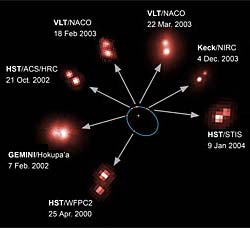First direct measurement of the mass of ultra-cool brown dwarf binary

This image shows the orbit of the brown dwarf around the ultra-cool L-dwarf. Each red dot on the orbit (in blue) corresponds to one observation made with a ground- or space-based telescope. The observations cover 60% of the whole orbit. Credit: ESA/NASA and Herve Bouy (Max-Planck-Institut für Extraterrestrische Physik/ESO, Germany) <br>Image credit: ESA/NASA and Herve Bouy (Max-Planck-Institut für Extraterrestrische Physik/ESO, Germany)
An international team of astronomers using the world’s biggest telescopes have directly measured the mass of an ultra-cool brown dwarf star and its companion dwarf star for the first time. Barely the size of the planet Jupiter, the dwarf star weighs in at just 8.5 percent of the mass of our Sun. This is the first ever mass measurement of a dwarf star belonging to a new stellar class of very low mass ultra-cool dwarf stars. The observation is a major step towards our understanding of the types of objects that occupy the gap between the lightest stars and the heaviest planets.
In 2000 the NASA/ESA Hubble Space Telescope detected a brown dwarf companion around the star named 2MASSW J0746425+2000321. In the subsequent four years the system was tracked by the NASA/ESA Hubble Space Telescope, the European Southern Observatory’s Very Large Telescope (Chile), the Gemini North (Hawaii) and the Keck Telescopes (Hawaii). The masses of the stars could be measured from the orbital motions of the two objects. With a mass of 8.5% of our Sun’s mass, the primary star is precariously close to the theoretical minimal fusion limit, which is 7.5 percent of our Sun’s mass. Objects below this limit are called brown dwarfs, failed stars or even super-planets, as their properties are more similar to those of large Jupiter-type planets than stars. The brown dwarf is measured to be 6.6 percent of the Sun’s mass, and thereby too puny to shine by nuclear fusion.
The mass measurements were made by an international team of astronomers led by Hervé Bouy from the Max-Planck-Institut für Extraterrestrische Physik/ESO, Germany and the Observatoire de Grenoble, France; Eduardo Martin (Instituto de Astrofisica de Canarias, Spain); and Wolfgang Brandner (Max Planck Institut für Astronomie, Germany).
To be able to compute the masses of the two stars, detailed observations of each component of the binary system were required and interpreted using the latest stellar evolutionary models. Because both objects are very close to each other, telescopes capable of providing high-resolution images were needed. The separation on the sky between the two stars is only about 1/20000 of a degree – similar to the size of a 1 Euro coin seen at a distance of about 25 km.
Furthermore, observations had to be performed over a long period of time (four years) to follow the motion of both objects around each other. Very accurate measurements of the relative position of the individual components were made, so that the full 10-year orbit of the binary system could be reconstructed. Once the orbit was known, the astronomers were able to use Kepler’s laws, first formulated four centuries ago, and some simple high school math to compute the total mass of the system. The distance between the two objects is around 2.5 times the distance from the Sun to the Earth.
Once the total mass of the system was known, very precise measurements of the brightness and temperature of each object taken by Hubble made it possible to split the total mass into the masses of the primary star and the brown dwarf companion.
Both components of the binary system belong to the L spectral class that includes the lowest mass stars and the highest mass brown dwarfs in our solar neighbourhood. This spectral class was discovered in 1997 and was added to the spectral classification that had remained unchanged for half a century. The L class is characterized by the formation of dust grains in the object’s atmosphere, which dramatically changes the visible-light spectrum.
Theoretically predicted for a long time, these sub-stellar objects called “brown dwarfs” were only discovered in 1995. Indirect techniques were conceived to identify brown dwarf candidates from their brightness and colour. However, the mass measurement is the only direct way to classify an object as a brown dwarf. Binary brown dwarfs are especially challenging because they are faint and lie very close to each other. Hubble or large ground-based telescopes using adaptive optics to cancel out atmospheric blur are therefore required to perform such studies.
The study opens a new chapter in the investigation of the dust-filled molecule-rich atmospheres of objects in the transitional zone between the lightest stars and the heaviest exoplanets.
Media Contact
More Information:
http://www.spacetelescope.org/news/html/heic0410.htmlAll latest news from the category: Physics and Astronomy
This area deals with the fundamental laws and building blocks of nature and how they interact, the properties and the behavior of matter, and research into space and time and their structures.
innovations-report provides in-depth reports and articles on subjects such as astrophysics, laser technologies, nuclear, quantum, particle and solid-state physics, nanotechnologies, planetary research and findings (Mars, Venus) and developments related to the Hubble Telescope.
Newest articles

First-of-its-kind study uses remote sensing to monitor plastic debris in rivers and lakes
Remote sensing creates a cost-effective solution to monitoring plastic pollution. A first-of-its-kind study from researchers at the University of Minnesota Twin Cities shows how remote sensing can help monitor and…

Laser-based artificial neuron mimics nerve cell functions at lightning speed
With a processing speed a billion times faster than nature, chip-based laser neuron could help advance AI tasks such as pattern recognition and sequence prediction. Researchers have developed a laser-based…

Optimising the processing of plastic waste
Just one look in the yellow bin reveals a colourful jumble of different types of plastic. However, the purer and more uniform plastic waste is, the easier it is to…


